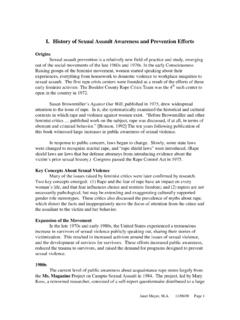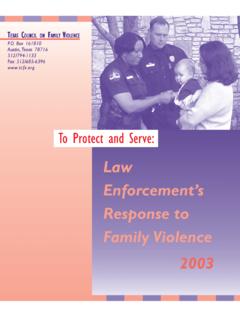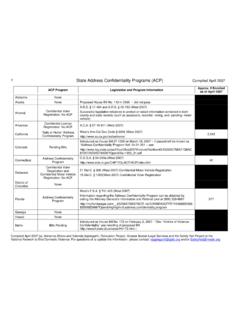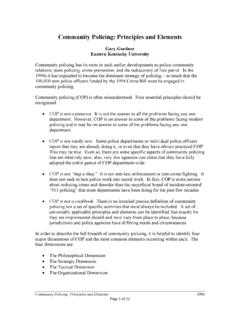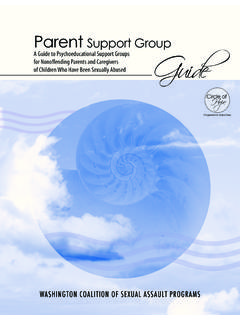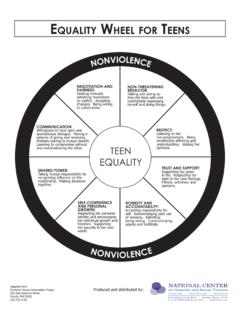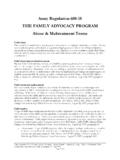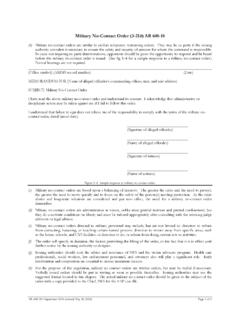Transcription of Best Practices Manual - National Center on Domestic and ...
1 FINAL DRAFT June 2000 ACADV 1 best Practices Manual For Domestic violence Programs ARIZONA COALITION AGAINST Domestic violence FINAL DRAFT June 2000 ACADV 2 TABLE OF CONTENTS TABLE OF CONTENTS .. 2 ACKNOWLEDGEMENTS .. 6 INTRODUCTION .. 7 Gender Specific 8 Grey Boxes .. 8 TERMINOLOGY .. 9 CRISIS INTERVENTION .. 12 12 12 Parad And Parad s Crisis Intervention Roller Coaster Model ..13 Crisis Intervention Skills For Advocates ..14 Safety Planning .. 16 While in an Abusive Relationship ..17 If She Plans To After She Safety Plans And Her Right To Self Determination ..21 Lethality Assessments .. 22 ADVOCACY .. 24 24 24 Types of Empowerment Style of Styles Of Advocacy Not Empowering To Women ..25 27 27 27 SAFE HOMES .. 30 30 Resources .. 30 30 Initial Contact and 32 Data 32 32 Physical 33 Termination/Follow-up/Community 33 SHELTER.
2 35 35 Initial Contact .. 35 Telephone Screening Intake .. 38 Intake .. 39 40 40 Guiding Principles of Rules ..41 Crisis Intervention/Advocacy/Counseling .. 43 Termination of Services and Follow-Up .. 43 FINAL DRAFT June 2000 ACADV 3 Planned or Voluntary Termination of Services ..44 Non-Voluntary Termination of Follow-Up ..45 Data Collection and Record Keeping .. 46 47 Publishing the Shelter Address ..48 Other Agencies Calling the Shelter ..48 Confidentiality Between Law Enforcement ..50 Individuals Donating Services/Touring Shelter Property ..51 Problem-Solving Issues .. 52 Individual 53 Grievance Procedure ..54 Physical 55 Building ..55 Supplies ..56 Security ..56 Accessibility ..57 Community Resources .. 58 Cultural 58 Undocumented Women .. 60 63 63 Initial Contact .. 63 Intake.
3 64 64 66 Data Collection/Record 67 Physical 67 Community Resources .. 67 CASE MANAGEMENT .. 69 69 Initial Contact .. 69 Intake .. 70 71 Termination and 72 Non-Voluntary Termination ..73 Data Collection and Record Keeping .. 74 Confidentiality and Individual Rights .. 74 Community Resources .. 75 COUNSELING .. 78 78 Initial Contact .. 79 79 Intake .. 80 Termination and 80 FINAL DRAFT June 2000 ACADV 4 Physical 81 Community Resources .. 81 SUPPORT GROUPS .. 83 83 83 Evaluation .. 86 CHILDREN S PROGRAMS .. 87 87 Initial Contact .. 88 Intake .. 89 89 91 Data Collection/Record 91 Confidentiality and Individual Rights .. 91 Physical 92 Community Resources .. 93 LEGAL ADVOCACY .. 94 94 Initial Contact .. 95 96 Undocumented Women .. 98 99 Data Collection/Record Keeping.
4 100 Confidentiality/Individual Rights .. 101 Physical 102 Community Resources .. 103 COMMUNITY EDUCATION AND 105 105 105 Data Collection/Record Keeping .. 108 109 General 109 Grievance Procedure ..110 Governing Body .. 111 Personnel Management .. 112 Volunteers .. 114 116 Resource 116 Fiscal Management ..117 118 Subpoenas and Search Warrants ..119 Program 121 123 Model Confidentiality Policy .. 123 Arizona Revised Statutes Duty to Report .. 135 Training Evaluation .. 138 FINAL DRAFT June 2000 ACADV 5 RESOURCES .. 139 139 140 FINAL DRAFT June 2000 ACADV 6 ACKNOWLEDGEMENTS Development of the best Practices Manual for Domestic violence Programs by the Arizona Coalition Against Domestic violence was made possible by funding through the Arizona Department of Health Services (DHS) and the Arizona Department of Economic Security (DES).
5 Special thanks are extended to the Residential Programs Committee, the Guidelines and Technical Assistance Committee (participants are listed below) and Tatro Consulting for their tireless efforts in the development of this Manual . It has taken many hours of meeting, traveling and reviewing in order for this document to come to fruition; for this the ACADV extends its heartfelt appreciation. Barbara Thompson Bridgette Terrazas C. Hermanex Carol Weaver Cathy Kutter Cecelia Lowe Cherrie Brennan Corinne Dwyer Dennis Dedman Diane Harris Diane Reese Flo Mills Jane Hauber Janice K. Martinez Jo Pierce Johniette Ball Judy Morris Kathleen Mitchell Keith Duncan Kerry Oliver Kimberly Graber Lucy Roark Michele Saldana Michelle Hayman Michelle Stapleton Michelle Toole Norma Frances Pamela Logon Renea Gentry Rumana Jabeen Ruth Laughter Sally Mason Sally Peoples Sharon Murphy Sharon Noly Sherry Sykes Stacey Magee Theresa Grates Theresa Truesdell Tracey Wilkinson Vickie Anderson ACADV staff should also be recognized for their efforts to produce this document.
6 Bahney Dedolph Danae Dotolo Danielle Langel Donna Crews Doreen Nicholas Judy Cunningham Kam Kowal Kristina Rivera Leah Meyers Lynne Norris Mary Wambach Michelle Hallett Sue Kaplan FINAL DRAFT June 2000 ACADV 7 INTRODUCTION This Manual is the product of a two-year effort by the Residential Programs Committee and the Guidelines and Technical Assistance Committee of the Arizona Coalition Against Domestic violence (ACADV). The committees were comprised of individuals from Domestic violence shelter programs, advocates, and ACADV staff. For the purpose of this project, an outside consultant facilitated the majority of the meetings. Members and volunteers produced this Manual in an effort to provide a reference and resource document for agencies planning, developing, implementing and improving Domestic violence victim service programs.
7 Participants identified a set of shared values and beliefs to guide the process of developing a comprehensive resource Manual for service providers. The stated mission of the project was to improve Domestic violence programs and enhance support for them by identifying and promoting best Practices . This was accomplished by: Developing a reference Manual resource guide Compiling a list of best Practices Creating a Manual that can serve as a model for others Participants recognized that these efforts are important in carrying out the mission in order to: Improve shelter programs (and other programs providing services to victims of Domestic violence ). Promote a consistent level of services within programs. Treat people with dignity and respect. Recognize the various needs of people requiring services and address those needs in an optimal way.
8 Educate policy makers, funders and others ( , agency boards of directors, donors, state legislators, tribal officials, Arizona Department of Economic Security and Arizona Department of Health Services). Influence public policy. Participants also identified a set of shared values and beliefs to guide the process of developing the resource Manual . We value: Respect for individuals, their culture, and the decisions they make. We believe all people are equal and deserve to be treated in a manner consistent with this belief. Open and honest communication, including active listening and maintaining an open mind during discussion. Respect for confidentiality of information. Making fair decisions. Program staff. Staff deserve to have the resources and support they need to be successful. FINAL DRAFT June 2000 ACADV 8 The involvement and leadership of those who are or have been victims of Domestic violence .
9 We believe: There should be zero-tolerance for Domestic violence in shelters, agencies, communities and the world. Victims of Domestic violence should not be blamed for their victimization. We are here to serve women and children we are committed to their welfare. We need to recognize the expressed and unexpressed needs of victims from their perspectives. We need to understand and confront our own attitudes and values. We need to address legal issues. Gender Specific Language The information and programs discussed in this Manual can apply to services for females or males; however, since the majority of this document addresses shelter services (which usually only serve females and children) the female gender is used to refer to the recipient of services. It is also important to acknowledge that the majority of victims who report Domestic violence are women.
10 Overwhelmingly, the perpetrators of the violence are male. However, there are incidents when males are victims of Domestic violence perpetrated by females and battering can occur in same sex relationships. Therefore, it is important to have services available for male and female victims and batterers. Grey Boxes Grey boxes are used throughout the document to provide specific examples of best practice services. The information is provided to highlight models and complement the information provided in the Manual . FINAL DRAFT June 2000 ACADV 9 TERMINOLOGY It is important to acknowledge that the contents of this Manual addresses issues concerning Domestic violence programs providing services directly or indirectly to victims of Domestic violence , family members, and friends. The term Domestic violence is also known as Domestic abuse, family violence , family abuse, intimate partner violence and partner abuse.
